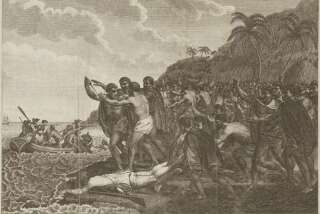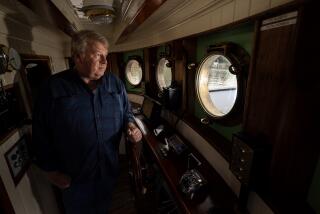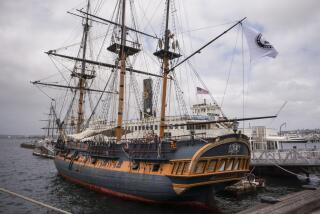The Magnificent Voyage of an Explorer
- Share via
It is one of the ironies of history that the achievements of some men are given little acclaim, while others are immortalized.
The overland expeditions of John C. Fremont made him a national hero. Oddly, a man who shared with Fremont in opening the Pacific Coast to exploration and settlement has almost been forgotten. He was Charles Wilkes, commander of an expedition sent out in 1838 to survey Antarctica, the Pacific islands, and the Pacific Coast.
Today more than 400 artifacts collected during Wilkes’ 4-year odyssey go on display for the first time in Los Angeles at the Natural History Museum in Exposition Park. The exhibit, “Magnificent Voyagers: The U.S. Exploring Expedition, 1838-1842,” is on loan from the Smithsonian Institution in Washington. The items collected by scientists on the 87,000-mile expedition formed the initial core of the Smithsonian’s now vast natural science collection.
On view are Indian masks from the Northwest Coast, models of the vessels in Wilkes’ squadron, basketry from the tribes of Oregon and California, giant shells, weapons, fishing gear, and apparel of the natives who inhabited Hawaii, Fiji, Tonga and other Polynesian islands where Wilkes anchored.
Visiting the Maori tribes in New Zealand, Wilkes acquired finely carved wood objects, including ornament boxes, canoe prows, and hand clubs and staves used in combat and ceremonies.
Documented in Artwork
The artists accompanying Wilkes made drawings of the people, places, objects and animals they encountered, and these are among the most interesting aspects of the exhibit.
One artist, Alfred Agate, had specialized in painting miniatures. He joined the expedition as a portrait and botanical artist. His drawings of scenes, sailors and the islanders were used to illustrate Wilkes’ five-volume “Narrative of the United States Exploring Expedition During the Years 1838, 1839, 1840, 1841, 1842,” published in Philadelphia in 1845.
Joseph Drayton was another artist whose main responsibility was to sketch the numerous specimens gathered by the naturalists. Wilkes, who had studied with many of the greatest scientists of the day, was also a capable artist.
Legislation for the U.S. Exploring Expedition was passed by Congress May 14, 1836. Wilkes, a naval lieutenant, was promoted over many senior officers to command the expedition, and was the personal choice of President Martin Van Buren because of Wilkes’ superior knowledge of the sciences. Six ships were selected for the voyage: two sloops-of-war, a brig, two smaller pilot boats and a store ship. The commander’s flagship was the Vincennes . They sailed from Hampton Roads, Va., in August, 1838.
Dissent and Deaths
Wilkes’ command consisted of 680 officers, scientists and enlisted men. His ability was unquestioned, but he proved a martinet. By all accounts, he was conceited, arrogant and domineering. His officers hated him. Several Marines died of disease during the long voyage, and two officers including the commander’s nephew were slain by natives in the Fiji Islands.
When the ships reached the end of their voyage in New York in 1842, Wilkes’ log reflected the accomplishments of a successful voyage. They had explored many of the islands of the South Pacific, reached Australia and New Zealand, gathered flora and fauna in Hawaii, identified Antarctica as a continent and charted the coasts of Oregon and California, entering San Francisco Bay in August, 1841. The Pacific Coast was a vast territory that a number of expansionists in Washington were eyeing with acquisition-at-any-price in mind.
The Oregon question was delicate. Agents of Britain’s Hudson Bay Co. were trading for furs in what is now Oregon, Washington, Idaho and British Columbia. The problem was settled amicably with Great Britain by treaty in 1846 when a boundary between the United States and Canada was established at the 49th parallel.
California would prove more difficult. It was under Mexican rule, and it would take a war to acquire it.
Presentation of the exhibit in Los Angeles has been made possible in part by Arco and the Occidental Petroleum Charitable Foundation. The Natural History Museum is located at 90 Exposition Blvd. Hours are 10 a.m. to 5 p.m. Tuesday through Friday; Saturday and Sunday, 9 a.m. to 6 p.m. through Labor Day. Admission is $3 for adults, $1.50 for seniors (older than 62) and full-time students with I.D., and 75 cents for children 5-12. The first Tuesday of each month is free for everyone. “Magnificent Voyagers” will be at the museum through Aug. 30. Information: (213) 744-DINO.
More to Read
Sign up for The Wild
We’ll help you find the best places to hike, bike and run, as well as the perfect silent spots for meditation and yoga.
You may occasionally receive promotional content from the Los Angeles Times.






